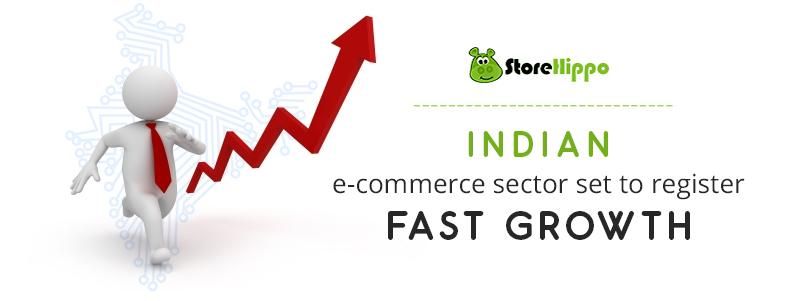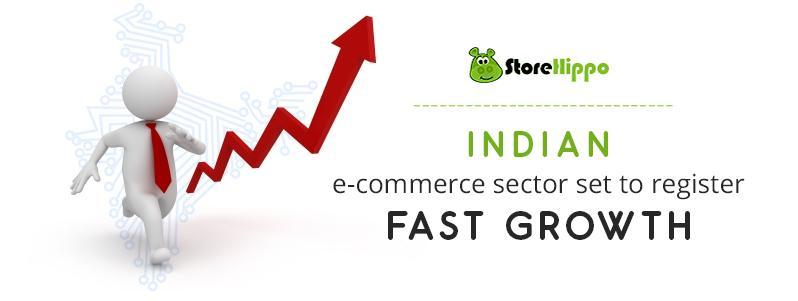Sun shines bright on Indian e-commerce sector
The sun is shining bright on the Indian e commerce landscape. According to a recent report by marketing research firm eMarketer, E-commerce sales in India are expected to grow from $14 billion in 2015 to $55 billion in 2018 (which translates into nearly a four-fold growth in a short span of three years). India has witnessed the fastest growth in the retail e-commerce sector among Asia-Pacific countries, growing 133.8% in 2014 and 129.5% in 2015. This growth will stabilize to 23.9% in 2019, compared with an Asia-Pacific projected average growth of 23.5%. The firm forecasts that the current Online retail in India which now accounts for 0.8% of all retail sales in India (compared with a global average of 6.3%) will grow to 4.8% by 2019 (when it is projected to be 12.8% globally). The report further elaborates that this spurt of growth in the Asia-pacific region is attributed to the rising middle class, rapid urbanization, huge popularity of the mobile devices coupled with faster, reliable and affordable Internet services.
The whole ecosystem in India is presently conducive for growth of e-commerce. Smartphones, tablets and other mobile devices have penetrated at a fast pace in India. The number of people who own mobile phones is greater than the number who own personal computers. The proliferation of mobile phones in India will bridge the digital divide by connecting millions of people. According to a report by FICCI and consultancy firm KPMG, India will have 350 million Smartphones by the year 2017. High speed data connectivity is one of the foundations on which the success of e-commerce is built. While the rural Indian sector relies on 2G, urban India now demands high speed technologies like 3G and 4G. Many telecom operators are investing in developing 3G and 4G networks to tap these customers. Bharti Airtel has launched its 4G service in about 300 cities. Vodafone recently launched 4G LTE services in two cities in Kerala. Reliance Jio is all set to launch its 4G services in India by December 2015 and will be launching the service with a slew of 4G smartphones along with the apps and services optimized for the faster network. Other notable telecom giant entering into the competition soon is Idea cellular. Other factors which have fuelled growth for this sector include digital wallet adoption, mobile apps payment services and last-mile logistics investments.
Rural India joins the digital revolution
The people living in rural India, tier-II and tier-III cities have adopted broadband and are comfortable to shop online and make payments via mobile payment apps. E-commerce companies are developing their site content in local languages and broadband internet has penetrated into rural India. These factors have brought the smaller towns of India into the ambit of e-tail sector. It is expected that by 2017 nearly 500 million Indians would be connected to internet, creating a huge consumer opportunity.
According to a study by Goldman Sachs, India's ecommerce market is expected to breach the $100-billion mark by FY20, on the back of increasing penetration of internet, Smartphone and spread of digital network in rural areas. According to a report titled 'Direct selling; Mapping the industry across Indian states', the country's e-commerce sector, which is around $10 billion (Rs 65,000 crore) at present, can even touch $250 billion in next ten years as digital network would spread in the rural areas.
The Goldman Sachs report said that the e-commerce market will account for 2.5% of India’s gross domestic product by 2030, growing 15 times and reaching $300 billion.
Government Initiatives
The present Government’s initiatives like Digital India, Skill India and Make in India have given a further boost to the sector. Internet usage has disseminated at a fast pace both in urban and rural India. In what could be a first for any country, India plans to set up a business-to-business international e-commerce platform exclusively for the country's manufacturers and exporters to sell their products to overseas vendors. The portal, which is being developed on the lines of Alibaba.com, will serve as a one-stop shop for exporters in other countries to buy every product that is made or value added in India, from needles to cars.The idea is to help make India a sourcing hub and get the country's exporters access to all foreign markets, which will revive falling exports and encourage 'Make in India' and 'Skill India' initiatives of the central government. India Brand Equity Foundation (IBEF), a trust set up by the commerce department, is building the online platform, and it will own and maintain the digital property related to this portal.
Competitive landscape heats up in India as top companies find greener online pastures
Reputed and well established E-commerce companies are likely to face competition as many local players are vying for their share of space in this segment by offering unique services, improving logistics and adopting mobile platforms. Flipkart, India’s largest online marketplace, has raised $3.15 billion in funding, while second-largest firm Snapdeal has raised $1.54 billion. Amazon.com Inc. chief executive officer Jeff Bezos has said he would invest as much as $2 billion in its Indian arm. Even specialized e-commerce companies like lingerie retailer Zivame (Actoserba Active Wholesale Pvt. Ltd) and women’s fashion portal Limeroad (A.M. Marketplaces Pvt. Ltd) have raised considerable amounts of money to capitalize on the opportunity.
Many brick-and-mortar entities also plan to enter the growing e-commerce market with the Tata group and the Aditya Birla Group announcing plans to join the e-commerce bandwagon. The $108-billion Tata group plans to add e-commerce to its portfolio and Tata Industries Ltd is said to have earmarked Rs.1,000 crore for its online retail initiative. The venture will also see the launch of a digital platform for healthcare services and a renewed focus on Big Data analytics. The proposed e-commerce website will offer both Tata and non-Tata brands across lifestyle, electronics and other segments. The group has signed up 80 brands, which will be offered on its website as well as through omni-channel options. The USD 40 billion Aditya Birla group is looking to enter in to Indian e-commerce market with plans to either acquire e-retailers or to launch a new stand alone e-commerce project. Another offline retailer, Kishore Biyani, also has been in news lately around speaking openly the shortcomings of existing online retailers. And his company, Future Group, recently announced a partnership with Amazon India, through which it will exclusively sell its apparel online.
Snapdeal recently raised USD 1 billion from eBay, Ratan Tata and Azim Premji; Japanese corporation Soft Bank had also invested USD 627 million in the Snapdeal. Amazon plans to spend USD 2 billion for extending its Indian operations. Flipkart, a rival of both Snapdeal and Amazon, closed USD 1 billion led by Tiger Global, DST and Accel Partners. Taiwanese electronics maker Foxconn Technology Group has announced an investment of $5 billion in India while Uber proposes to invest $1 billion in the country in six-nine months to expand and improve operations. The Reserve Bank of India issued 11 payment bank licences, which are expected to catalyse the e-payment landscape.
E-commerce: the way ahead
E-commerce benefits the buyers as they get a plethora of products and brands. The sellers get an opportunity to grow their businesses by tapping new markets. India is at the threshold of a digital revolution, as can be gauged from a quote by Diego Piacentini, senior vice president for international business at Amazon, "In the next few years, India will be the second-biggest market for us (after the US).” Today, if a company needs to be successful then embracing e-commerce is an imperative. India is poised for a digital revolution and sooner or later all companies will have to build a digital future.
https://www.storehippo.com/
9th Floor, Spaze iTech Park, A1-Tower, Sector-49 Sohna Road, Gurgaon, Haryana 122018, CIN - U72200HR2015PTC054459
122001
Gurgaon
IN
StoreHippo
https://www.storehippo.com/
9th Floor, Spaze iTech Park, A1-Tower, Sector-49 Sohna Road, Gurgaon, Haryana 122018, CIN - U72200HR2015PTC054459
Gurgaon,
IN
+918010117117
https://www.storehippo.com/s/5667e7d63086b2e718049ad9/ms.settings/521c4d7548c284890e000001/594a155440e9fb9e592f2ba9-480x480.png"
[email protected]
https://www.storehippo.com/en/blog/indian-e-commerce-sector-set-to-register-fast-growth
Indian e-commerce sector set to register fast growth
2016-03-02T06:33:54.754Z
2020-07-06T13:35:07.705Z


storehippo
Information
Explore
Features
© copyright 2020 StoreHippo.com . All Rights Reserved.




















Leave A Comment